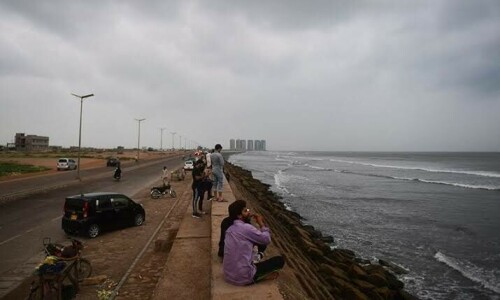LIFE is cyclical — what goes around, comes around. The ancients believed that in a full lifetime, if you are born rich, you will suffer poverty but die rich. If you are born poor, you may see riches but die poor.
Pakistan was born poor — Jinnah’s “moth-eaten country” rescued at birth by the intervention of M.K. Gandhi who forced Nehru’s government to release the Rs55 crores due to it. A lifetime later, Pakistan is still poor, with about $4 billion to its name and external debt and liabilities of $126bn. To whom does it owe all this money?
One US analyst has categorised its creditors into: multilateral debt, Paris Club debt, private and commercial loans, and Chinese debt.
Multilateral creditors include the World Bank ($18bn), the Asian Development Bank ($15bn) and the IMF ($7.6bn). Smaller amounts are owed to the Islamic Development Bank and the Asian Infrastructure Investment Bank.
A lifetime later, we remain poor.
Interest on these is concessional and the burden of repayment spread over 18 to 30 years, which explains why repayments of $4.5bn for the year to multilateral creditors represented a fifth of the total debt repayment. A second category — Paris Club debt — is owed to 22 creditor countries — Japan, Germany, France and the US. It amounts to $8.5bn, repayable over 40 years with 1pc interest rate.
To private debtors, we owe $7.8bn in the form of Eurobonds and Sukuk bonds, and to commercial lenders — mostly Chinese financial institutions — another $7bn. Commercial loans are short-term and carry biting rates of interest.
Our obligations to the Chinese are higher than the Himalayas. We owe China about $27bn. Of this, $10bn is bilateral debt, $6.2bn provided by the Chinese government to Pakistani public-sector enterprises, and $7bn Chinese commercial loans.
In 2024-25, it is estimated that Pakistan’s debt repayment and servicing alone will be about $24.6bn. In 2025-26, the debt-servicing burden will be no easier to bear. It is predicted at approximately $23bn.
‘Where did all this money go?’ is a question many Pakistanis who are still waiting to vote can ask, with justification. There is no new Mangla or a second Tarbela. No bullet trains hurtle across our dehydrated landscape. We are nuclear but remain starved of conventional power. We have insufficient schools, too few universities, inadequate hospitals and medical facilities, and stagnant job creation.
Some remember with nostalgia the days when saner governments used the Planning Commission as a tool to regulate equitable development across the country. Five-year plans were declarations of national priorities, and each annual development programme tried to balance federal and provincial demands with available resources, foreign and local.
These plans and programmes were like the Ten Commandments — only as good as those who abided by them. Some rulers were tempted to bypass such fiscal discipline.
In 1969, soon after martial law had been declared, Air Marshal Nur Khan (then deputy chief martial law administrator) called on Mr Qamar-ul-Islam (then the powerful secretary, Planning Commission). Nur Khan asked him for an economic plan. “Do you want a short-term one or a long-term one?” the sage bureaucrat replied. “What is the difference?” the DCMLA retorted testily. “Depends on how long you intend to stay in power.”
Not surprisingly, later governments found the constraints of the Planning Commission irksome. In India, Prime Minister Modi (for different reasons but with the same intent) dissolved the Indian Planning Commission in 2015, replacing it with NITI Aayog (National Institution for Transforming India).
In Islamabad, the Planning Commission exists as a ministry. It functions, but in name, miming fiscal control. The ministry crunches numbers but with all the bite of a toothless geriatric.
Where is the power of the PC-1 form without which no project could be considered for inclusion in the government’s budgetary system? Where is the authority of the Central Development Working Party, a filter that preceded submission of justifiable projects to the Executive Committee of the National Economic Council?
In 2006, a Charter of Democracy was signed by Nawaz Sharif and Benazir Bhutto. It envisaged political harmony and reconciliation, yielding a strong democratic system. That charter, though not dead, is buried.
The latest mantra by their successors is a ‘charter of economy’. Can a coalition of 13 disparate political parties be expected to agree on a common list of economic priorities? They cannot even agree on an election date that will decide their future.
Meanwhile, a beleaguered Imran Khan is made to bide his time in forced isolation. He plots revenge. He may find more productive solace in the retort of the defeated royalist to Cromwell’s supporters during the English Civil War: “Now that you have done with us, go fight amongst yourselves!”
The writer is an author.
www.fsaijazuddin.pk
Published in Dawn, June 22nd, 2023













































Dear visitor, the comments section is undergoing an overhaul and will return soon.